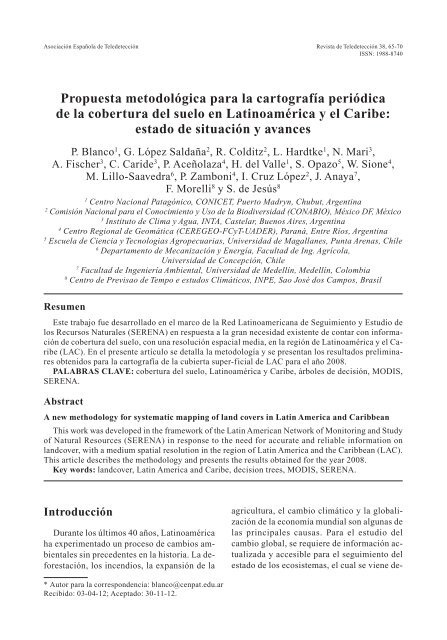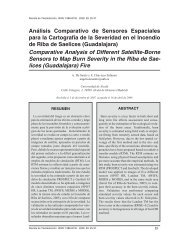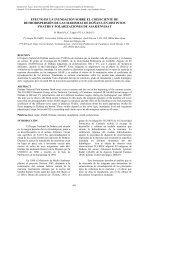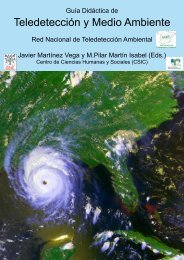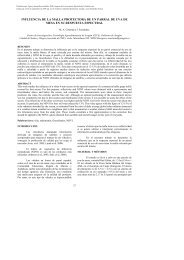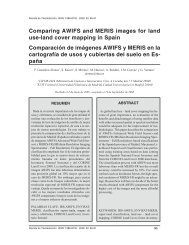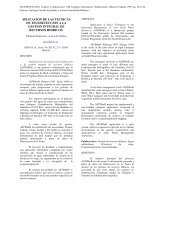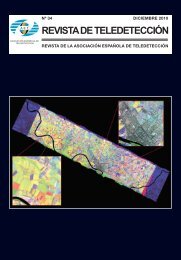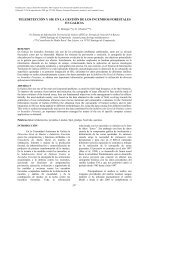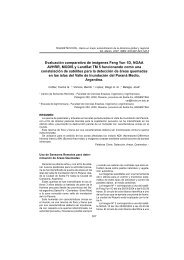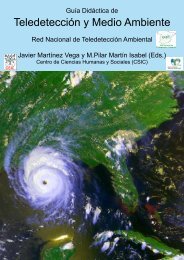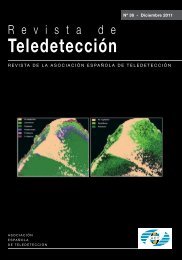00_cubiertas 38 v1 - Asociación Española de Teledetección
00_cubiertas 38 v1 - Asociación Española de Teledetección
00_cubiertas 38 v1 - Asociación Española de Teledetección
You also want an ePaper? Increase the reach of your titles
YUMPU automatically turns print PDFs into web optimized ePapers that Google loves.
Asociación Española <strong>de</strong> Tele<strong>de</strong>tección Revista <strong>de</strong> Tele<strong>de</strong>tección <strong>38</strong>, 65-70<br />
ISSN: 1988-8740<br />
Propuesta metodológica para la cartografía periódica<br />
<strong>de</strong> la cobertura <strong>de</strong>l suelo en Latinoamérica y el Caribe:<br />
estado <strong>de</strong> situación y avances<br />
P. Blanco 1 , G. López Saldaña 2 , R. Colditz 2 , L. Hardtke 1 , N. Mari 3 ,<br />
A. Fischer 3 , C. Cari<strong>de</strong> 3 , P. Aceñolaza 4 , H. <strong>de</strong>l Valle 1 , S. Opazo 5 , W. Sione 4 ,<br />
M. Lillo-Saavedra 6 , P. Zamboni 4 , I. Cruz López 2 , J. Anaya 7 ,<br />
F. Morelli 8 y S. <strong>de</strong> Jesús 8<br />
1<br />
Centro Nacional Patagónico, CONICET, Puerto Madryn, Chubut, Argentina<br />
2<br />
Comisión Nacional para el Conocimiento y Uso <strong>de</strong> la Biodiversidad (CONABIO), México DF, México<br />
3<br />
Instituto <strong>de</strong> Clima y Agua, INTA, Castelar, Buenos Aires, Argentina<br />
4<br />
Centro Regional <strong>de</strong> Geomática (CEREGEO-FCyT-UADER), Paraná, Entre Ríos, Argentina<br />
5<br />
Escuela <strong>de</strong> Ciencia y Tecnologias Agropecuarias, Universidad <strong>de</strong> Magallanes, Punta Arenas, Chile<br />
6<br />
Departamento <strong>de</strong> Mecanización y Energía, Facultad <strong>de</strong> Ing. Agrícola,<br />
Universidad <strong>de</strong> Concepción, Chile<br />
7<br />
Facultad <strong>de</strong> Ingeniería Ambiental, Universidad <strong>de</strong> Me<strong>de</strong>llín, Me<strong>de</strong>llín, Colombia<br />
8<br />
Centro <strong>de</strong> Previsao <strong>de</strong> Tempo e estudos Climáticos, INPE, Sao José dos Campos, Brasil<br />
Resumen<br />
Este trabajo fue <strong>de</strong>sarrollado en el marco <strong>de</strong> la Red Latinoamericana <strong>de</strong> Seguimiento y Estudio <strong>de</strong><br />
los Recursos Naturales (SERENA) en respuesta a la gran necesidad existente <strong>de</strong> contar con información<br />
<strong>de</strong> cobertura <strong>de</strong>l suelo, con una resolución espacial media, en la región <strong>de</strong> Latinoamérica y el Caribe<br />
(LAC). En el presente artículo se <strong>de</strong>talla la metodología y se presentan los resultados preliminares<br />
obtenidos para la cartografía <strong>de</strong> la cubierta super-ficial <strong>de</strong> LAC para el año 2<strong>00</strong>8.<br />
PALABRAS CLAVE: cobertura <strong>de</strong>l suelo, Latinoamérica y Caribe, árboles <strong>de</strong> <strong>de</strong>cisión, MODIS,<br />
SERENA.<br />
Abstract<br />
A new methodology for systematic mapping of land covers in Latin America and Caribbean<br />
This work was <strong>de</strong>veloped in the framework of the Latin American Network of Monitoring and Study<br />
of Natural Resources (SERENA) in response to the need for accurate and reliable information on<br />
landcover, with a medium spatial resolution in the region of Latin America and the Caribbean (LAC).<br />
This article <strong>de</strong>scribes the methodology and presents the results obtained for the year 2<strong>00</strong>8.<br />
Key words: landcover, Latin America and Caribe, <strong>de</strong>cision trees, MODIS, SERENA.<br />
Introducción<br />
Durante los últimos 40 años, Latinoamérica<br />
ha experimentado un proceso <strong>de</strong> cambios ambientales<br />
sin prece<strong>de</strong>ntes en la historia. La <strong>de</strong>forestación,<br />
los incendios, la expansión <strong>de</strong> la<br />
agricultura, el cambio climático y la globalización<br />
<strong>de</strong> la economía mundial son algunas <strong>de</strong><br />
las principales causas. Para el estudio <strong>de</strong>l<br />
cambio global, se requiere <strong>de</strong> información actualizada<br />
y accesible para el seguimiento <strong>de</strong>l<br />
estado <strong>de</strong> los ecosistemas, el cual se viene <strong>de</strong>-<br />
* Autor para la correspon<strong>de</strong>ncia: blanco@cenpat.edu.ar<br />
Recibido: 03-04-12; Aceptado: 30-11-12.


